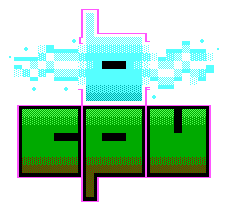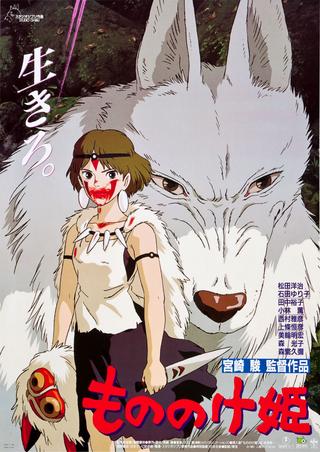

A week or so ago, I watched Princess Mononoke for the first time in about 20 years. I remember watching it when I was much younger and enjoying it, but not really getting it. Much of it passed over my head really. Now that I'm older, my critical skills are greater and I've learned a little more about art and story-telling and I have to say, I think it might be my favourite Studio Ghibli film! Of course, Spirited Away and My Neighbour Totoro get the Lion's share of media attention, but I think Princess Mononoke has a lot to say that's quite relevant today. The art certainly reached me, you might say.

In case you haven't heard of them, Studio Ghibli are a Japanese Animation studio. I think it's fair to say they are quite a big deal in the animation - nay! - international movie business! Many of their films are beloved classics the world over. I'd say they tend towards the classic children's tales of old, but with a depth and artistry that adults can also enjoy.
How ironic then, that also a couple of weeks ago, OpenAI released a Studio Ghibli Generator as part of it's Chat GPT4o offering. Maybe more than just ironic - downright disturbing!
But let's start at the beginning...
How do you define what is and isn't art? In his Reith Lectures, Grayson Perry talks a little about this1. He jokes about his desire to have the super power where he could declare something not art, then giggle as all the previously super expensive stuff in the galleries lose their value when he points at them. It's definitely worth a listen. What I gleaned from them is that defining art is somewhat hard, but not impossible. I think we can certainly come up with a useful definition - even if it's not 100%, we can do some work with it at least.
I've heard it said that "art has no point but itself", which seems to me to be on the right track. I'm no art historian or critic so what I offer here is something more general that I think gets us somewhere. Art is a conversation where what is being conveyed is something between human beings that cannot be conveyed directly. Something about the human experience, its complexity, its subjective, conscious, self aware state. Something to be conveyed that you feel.
I suspect everyone reading this blog has been moved by art at some point in their lives. Poetry, a classical painting or just a really good pop song. No matter what it is, I bet you'll have felt something2. It's one of, perhaps the best tool we have for communicating the un-communicatable. A communication that takes place between people.
So by our definition there, an A.I. can't do art right? A.I doesn't have agency; it doesn't do anything unless we ask it to. We humans have a tendency to ascribe human features to non-humans. We do it all the time, even when we shouldn't. One example - I'm a big fan of owls, but if you approach an owl straight on, making eye contact with a smile on your face, chances are you'll stress out the poor bird. What would be considered a polite thing to do in human society is considered the actions of a predator by an owl.
Sometimes, it's good to take a step back. A.I isn't sentient, self-aware or conscious3. We really shouldn't use the word hallucination when an A.I. system returns an incorrect result. And I don't think we can consider A.I to be doing art. The language being used by folks when talking about A.I seems to suggest we are already ascribing human qualities to a tool.
The line gets a little blurred when an artist picks up this tool4. I quite enjoy the music video for the song Ghost, by Gunship. Clearly, there's thought and artistry behind it. I doubt the same is true when someone picks up an A.I tool and generates a Ghibli Selfie.
Every character in the Ghibli films uses some form of technology. Just as we attempted to define art, let's define technology too. The most elegant definition I can come up with is technology is any tool that is not found in nature. So a stick on the ground can be used as a tool, but it's not technology. We can double down on this definition by looking at etymology - the Greek Word Tekhne - meaning art or craft. Wikipedia says the same(ish) thing in different words - "the application of conceptual knowledge to achieve practical goals".
I've noticed that Miyazaki tends to view technology in a - shall we say - critical light. In Nausicaa: Valley of the Wind, the villains of the story have great airships, automatic weapons, tanks and such, whereas our heroine has a glider and a small rifle. Her people use wind power and simple tools, whereas the invaders use engines and machines. In Howls Moving Castle.
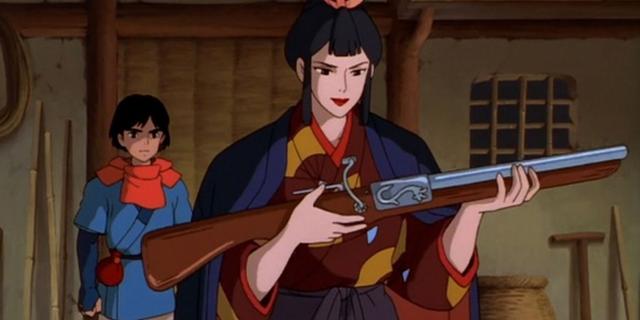
The keen eyed among you might remark that in Nausicaa, the heroine's glider is actually jet assisted. Apparently, Miyazaki really loves flying - now I think about it, many of the characters fly using some form of technology (and occasionally magic)5. By our definition though, everyone - villain or hero- uses technology. Yet there is something else going on underneath I think.
I believe that Miyazaki might have a similar view on technology to me - the good kind is a tool that enables us to achieve something more human, more connected, more expression of self. The bad kind tends to limit our thinking, our connections and our spirit. Nausicaa's Jet glider allows her freedom and expresses her daring do! In Porco Rosso, the planes are everything to the pilots who fly them. In The Boy and the Heron, the lead characters builds his own bow, a tool through which he expresses his heroism. In all these cases, technology enables the characters to be who they really already were.
In our more mundane lives, I often think that the bicycle is a great example of this sort of thing. They are easily understood (for the most part), require nothing but a little skill and energy, but what they provide is the freedom to roam further and quicker than you could before. An early taste of freedom. Contrast that with A.I - a technology that is very complex and understood by a few, can only be built by these with vast amounts of money at their disposal and if it's not discriminating against minorities6 it's wasting hard working people's time7. When the time "A.I. slop" is being bandied around a lot, you have to wonder that there might be a problem.
I'm sure folk will be quick to tell me that technology is neutral (strong disagree!); A.I. has done good things (I agree!) and that it's all in how you use it. But I think, if we are all being honest, deep down I think we know which side of the Miyazaki technology line A.I is on.
Lets swing back around to where we started. Princess Mononoke tells the story of Prince Ashitaka - in the main - and also the titular heroine. If you've read the book The hero with a Thousand Faces by Joseph Cambell, the story will feel familiar. If you haven't, you are in for a treat. Cambell makes the argument that human-beings have been telling the same story for quite some time - a monomyth. From Wikipedia:
A hero ventures forth from the world of common day into a region of supernatural wonder: fabulous forces are there encountered and a decisive victory is won: the hero comes back from this mysterious adventure with the power to bestow boons on his fellow man.
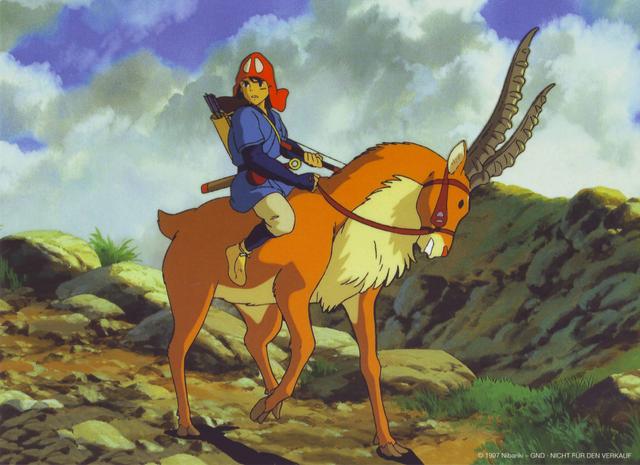
The modern example is the first Star Wars movie - so much so that Luke Skywalker features on the cover of one of the editions. Prince Ashitaka is no different. He is called to adventure when the evil in the world makes itself known to him and his people. He is cursed and told he must leave his homeland. He meets a number of characters, including the leader of the local mining town - Eboshi - and the eponymous heroine, Princess Mononoke. Together, they fight to save the land from these who are greedy and misguided, ultimately saving the spirit of the forest together.
This coming together of the male and female heroes is a major part of the journey that I think is often overlooked. It's not about one bedding the other, or some sort of saccharine Prince Charming waking sleeping beauty. If you've ever seen the movie Fight Club, right at the end, when the hero has triumphed and the boon is just about to be delivered to the world, the narrator takes Marla Singer's hand and sees her - really sees her - for the first time. In the same short snippet, she sees him. Princess Mononoke is no different in the regard.
Why is the important to the OpenAI irony point? Glad you asked! Let's take a sidewheel!
So this will be relevant I assure you (and hopefully interesting!). Miyazaki has often been considered a bit of a feminist. Many of his heroes are young women. In Princess Mononoke, the antagonist Eboshi is a sympathetic villain in that she provides work for women who would otherwise be forced to work as prostitutes, as well as employing people with leprosy whom the rest of the world have turned their backs on. The key female characters in Miyazaki's films are fully realised and quite important to the plot, whether they are heroic or villainous.
So I'm going to take a different tack and look at the film from a masculine perspective and argue that Prince Ashitaka is a great example of positive masculinity. Since we've tried to define art and technology, we should probably try to define masculinity as well. Now, this is quite the challenge, but there is at least one lens I know of that we can use to analyse Ashitaka through - Jungian Archetypes.
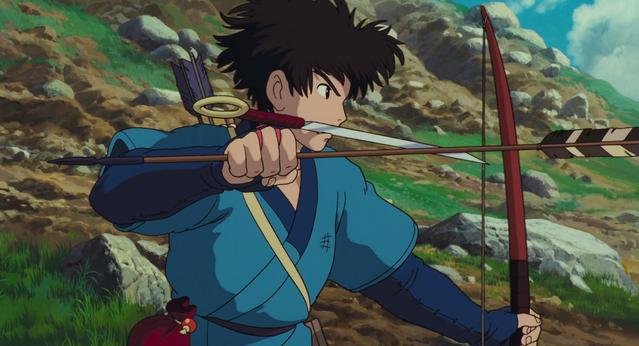
King, Warrior, Magician, Lover by Robert Moore describes masculinity using these four archetypes, what positive masculinity looks like, and how it can turn toxic if not properly nurtured and guided. Yep, it's one of the earliest mentions of the phrase "toxic masculinity" I've heard (and it doesn't seem to mean what people think it means today). The King archetype rules, but knows he is not absolute and that power comes with responsibility. The warrior isn't really about violence, but is about training and then acting decisively when needed. The magician has knowledge that is hard earned, knowledge that is powerful but should be shared. The lover isn't really about sex, but is about deep connection with all things. I've not done the book full justice there, but it's a start.
Ashitaka is all these things. For starters, he's already a prince, but he is beloved by his people who see him as a protector, not a tyrant. He is clearly a warrior, ready to act with skill and bravery, but he's certainly not a fan of violence. He is the magician as he knows the secret ways of the forest and trusts in that knowledge. Finally, he is the lover - he cares for the world, the characters in it and is connected to something bigger than himself.
So why the side-wheel? Well, there is another kind of hero - although I hesitate to use the term. From her books - most notably The Fountainhead and Atlas Shrugged - Ayn Rand gave us the term "Randian Hero". Such a character is interested only in their own ideals and goals, striving to achieve them at all costs. Rand's philosophy of Objectivism - or perhaps more rightly, individualism - has been debated, copied, praised and criticised for quite sometime. However, I think the most relevant critique of this kind of hero is given by Adam Curtis in his film All watched over by machines of Loving Grace. In the film, Silicon Valley entrepreneurs are interviewed, who self describe as Randian Heroes, changing the world and battling the status quo - that ruthlessly pursuing one's own ideals is the only true moral value. The implication is do as you will and damn the consequences.
Remember the phrase that was all the rage a few years back - "Move Fast and Break Things?". Remember how everyone thought that was cool? At first we all got excited but now, things are broken, enshittified8, and we, the consumers of technology are the real product.
On the face of it one might say that Ashitaka is no different to any other hero. He fights these who oppose him and has the strength to follow his own ideals. Surely, that's no different to today's tech visionaries? On the contrary, I think the two are so far apart in the deepest way. One seeks to impose their will no matter what. The other is connected to something much bigger than themselves. One is selfish and denies emotion, the other accepts themselves but sacrifices their own ego for the good of a greater cause. I don't see any silicon valley CEO going penniless to help these less fortunate. Indeed, much of the valley seems segregated between these who turns up to work in fancy offices they don't need to leave, and the destitute who sleep rough on the streets outside these tech company offices.
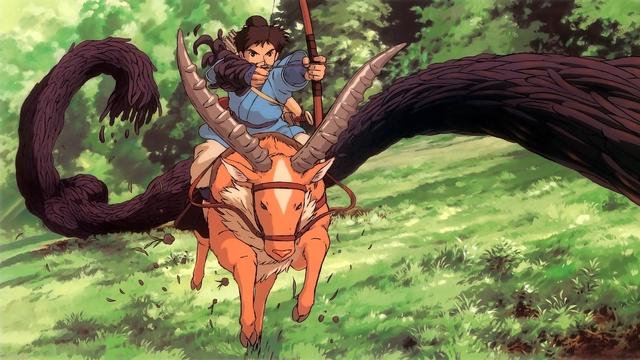
The CEO of OpenAI is a man - Sam Altman - and I suspect many of the engineers who work there are men too; certainly, in 2023 it's board was entirely male9. So we can look at the company and apply our heroic masculinity lens and ask ourselves which one, if either, is OpenAI? I suspect we all know the answer.
We are in need of heroes I think. These heroes who, because of their deep connection to the world, know the evil that has to be faced.
I think this Ghibli character generator is deeply ironic. Studio Ghibli try to show us how to be truly heroic men and women. A fact that has sailed over all the heads at OpenAI.
Grayson Perry is probably my main 'goto artist' when I need some art explaining. ↩
We can talk about The Death of the Author at some point, but I think the definition holds, even if what the artist intended isn't necessarily what you got from it. ↩
Consciousness seems to have no real definition, though my personal thinking is that it means being able to experience qualia. It's a weasel word used a bit too often and a bit too incorrectly. However, the relationship between A.I and qualia might be worth exploring. ↩
All lines get blurred when you zoom in enough. ↩
According to this line on wikipedia ↩
This has been a long running concern, but this link on Politico is quite interesting. ↩
Apparently, the developer of the extremely popular program curl is not happy about it. ↩
A term coined by Cory Doctorow. It even has it's own Wikipedia page. I had no idea it had struck such a chord! ↩
According to this article in wired ↩
